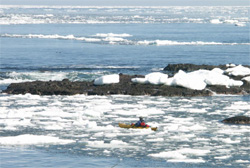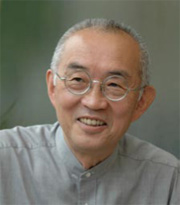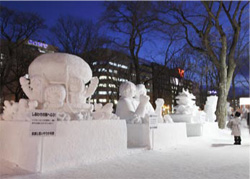Home > Highlighting JAPAN > Highlighting Japan FEBRUARY 2013 > WINTER WONDERLAND
Highlighting JAPAN
COVER STORY: WINTER WONDERLAND
WINTER WONDERLAND
The Japanese archipelago extends 3,000 kilometers from north to south and is divided into east and west by mountains—the Pacific side and Sea of Japan side. The climate thus differs considerably from region to region. The four seasons are distinct as winters are extremely cold and snowy, especially in Hokkaido and the Tohoku and Joshinetsu regions, while it is warm in Okinawa and the other southwestern islands. The average temperature in Rikubetsu-cho, a town in eastern Hokkaido called the coldest place in Japan apart from Mt. Fuji, in January averages -11.4°C. In contrast, the average January temperature on Hateruma island, Okinawa Prefecture is 19.2°C. This makes for a 30-degree difference from north to south. Moreover, in summer, the highest temperature in Rikubetsu-cho sometimes reaches 30°C, so the temperature difference is very wide between winter and summer.
In the variety of climates, different customs and cultures have been developed in Japan in accordance with the seasons and regions. This month's Cover Story is all about Japan's harsh winter.

Professor Yoshio Tsukio paddles a sea kayak through drift ice off the Shiretoko Peninsula
Credit: COURTESY OF YOSHIO TSUKIO

Professor Yoshio Tsukio
Professor Tsukio specializes in media policy and systems engineering and is a pioneer in information technology (IT) in architectural design. He is also active in the fields of regional development and environmental conservation, and advises on regional development in Hokkaido and Tohoku. He enjoys kayaking and cross-country skiing, and is a so-called Cape Horner—someone who has paddled through a route around Cape Horn, the tip of South America, known as one of the most challenging nautical routes.
Local people have regarded drift ice as a nuisance obstructing their fishing, but in recent years the ice has become the main attraction in the winter. Many tourists from home and abroad join cruises on ice-breaking ships on the Sea of Okhotsk from late-January to late-March. Walking on drift ice guided by fishermen on their winter break has become popular among tourists in recent years.

Each year more than two million people from home and abroad visit the Sapporo Snow Festival, where more than 200 snow and ice statues are displayed. The 64th festival will be held February 5–11, 2013.

The 25th Showa-Shinzan International Yukigassen competition will be held in Sobetsu in southwest Hokkaido on February 23 and 24. This competition is said to be the largest yukigassen (snowball fight) in the world. Strict rules have been set and yukigassen has changed from just play into a sporting event. Last year around 150 teams and 1,500 people, who won preliminary games nationwide, participated in the competition, and over 600 people from about 70 countries and areas outside Japan have participated since the competition began.
Credit: COURTESY OF SHOWA-SHINZAN INTERNATIONAL YUKIGASEEN EXECUTIVE COMMITTEE
The winter cold is indispensable to some traditional crafts. The process of making washi (traditional Japanese paper) involves the use of cold water in the winter. In a dyeing method called yuzenzome, which is practiced in Kyoto and Kanazawa, dyed fabric was put in cold river water in the winter to remove extra starch and dye. This technique, called yuzen nagashi, was a common sight in these cities in winter.
"The human race used its ingenuity to overcome difficulties in winter before it invented the products of modern civilization. Part of its ingenuity was learning to use the forces of nature, including snow and cold," Professor Tsukio says. "And this ingenuity is not just something inherited from the past. It is important to rethink Japanese culture associated with winter and snow in this age of the environment."
© 2009 Cabinet Office, Government of Japan






